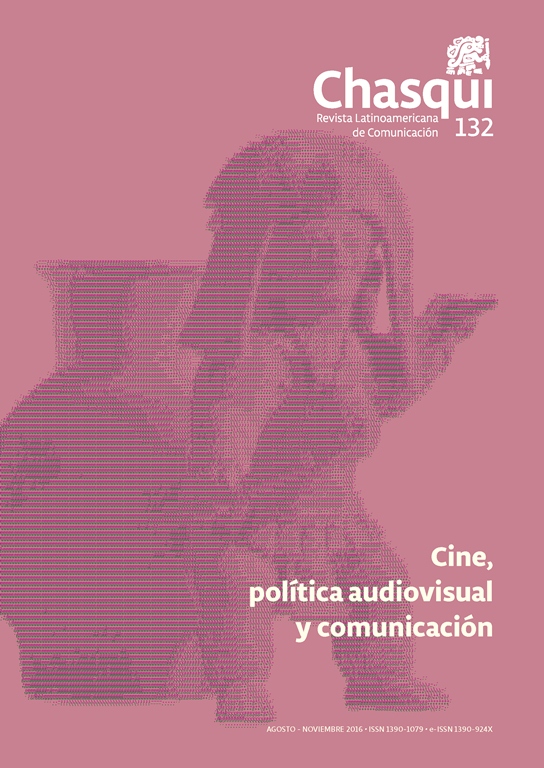Popayán (Colombia) urban narrative in the first half of the twentieth century. Between the Nobility and the Patriciate
DOI:
https://doi.org/10.16921/chasqui.v0i132.2675Keywords:
narrative, Popayan, nobility, patriciateAbstract
Based on the definitions of noble city and patrician city presented by José Luis Romero in his book Latinoamérica: las ciudades y las ideas, this research focuses on how was constructed Popayan Urban Narrative in the first half of twentieth century. The analysis is rooted in the historical essay originated in the city which, eventually, became in an essential source for the traditional urban narrative in the City. This narrative has operated in the logic of a hegemonic and eurocentric thought, where the colonial discourse is still present and latent in the various forms in which the city is recognized and named.References
Álvarez, A. (2003). Los medios de comunicación y la sociedad educadora. ¿Ya no es necesaria la escuela? Bogotá: Magisterio.
Aragón, A. (1930). Popayán. Popayán: Imprenta del Departamento.
Aragón, A. (1939). Fastos payaneses (Tomo I). Bogotá: Imprenta Nacional.
Aragón, A. (1941). Fastos payaneses (Tomo II). Bogotá: Imprenta Nacional.
Arroyo, J. (1955). Historia de la Gobernación de Popayán. Bogotá: Santa Fe.
Buendía, A. (2014). Narrativas urbanas y jóvenes escolarizados en Popayán. Comunicación y educación en la formas de narrar y habitar la ciudad. Tesis doctoral. Popayán: Rudecolombia - Universidad del Cauca.
Bustamante, J.I. (1939). Historia de la poesía en Popayán. (1536-1939). Popayán: Talleres Editoriales del Departamento.
Crist, R. (2008). La personalidad de Popayán. Cuadernos de antropología y poética, 1(1), pp. 59-73.
Hollingsworth, J. S. (1975 ). Valores de dirigentes y estudiantes de Popayán. En I. Webber, & A. Ocampo (Eds.). Valores, desarrollo e historia: Popayán, Medellín, Cali y Valle del Cauca (pp. 131-150). Tercer Mundo.
Martínez Delgado, L. (1959). Popayán, ciudad procera. Bogotá: Kelly.
Mumby, D. (1997). Introducción: narrativa y control social. En D. Mumby (Comp.). Narrativa y control social, (pp. 11-25) Buenos Aires: Amorrortu.
Ochs, E. (2000). El discurso como estructura y proceso. En T. Van Dijk. Narrativa (pp. 271-304). Barcelona: Gedisa.
Olano, A. (1910). Popayán en la colonia. Popayán: Instituto de Investigaciones Históricas.
Rama, A. (2004). La ciudad letrada. Santiago: Tajamar Editores.
Romero, J. L. (1999). Latinoamérica: las ciudades y las ideas. Medellín: Universidad de Antioquia.
Tocancipá, J. (2006). Cafés en la “Ciudad Blanca”: identidad, crisis cafetera y el restablecimiento del orden social en Colombia. Revista de Estudios Sociales (25), pp. 67-79.
Urreste, J. (2008). Entre el tiempo y el espacio, o sobre plazas, campanas e iglesias en Popayán En M. Córdova (Ed.). Lo urbano en su complejidad: una lectura desde América Latina (pp. 325-338). Quito: Flacso.
Ricoeur, P. (2003). Tiempo y narración III. El tiempo narrado. México D.F.: Siglo XX.
Ricoeur, P. (2004). Tiempo y narración I. Configuración del tiempo en el relato histórico. México D.F.: Siglo XXI.
White, H. (1992). El contenido de la forma. Narración, discurso y representación histórica. Barcelona: Paidós.
White, H. (2001). Metahistoria. La imaginación histórica en la Europa del siglo XIX. México: FCE.
White, H. (2003). El texto histórico como artefacto literario y otros escritos. Barcelona: Paidós.
Whiteford, A. (1963). Popayán y Querétaro. Comparación de sus clases sociales. Bogotá: Universidad Nacional de Colombia, Facultad de Sociología.
Whiteford, A. (2008). What is Popayán? (H. Torres, Ed.) Cuadernos de antropología y poética, 1(1), pp. 13-27.
Downloads
Published
Issue
Section
License
- Authors retain copyright and grant the journal right of first publication with the work simultaneously licensed under a Creative Commons Attribution-NoDerivs License (CC BY-ND) that allows others to share the work with an acknowledgement of the work's authorship and initial publication in this journal.
- Authors are able to enter into separate, additional contractual arrangements for the non-exclusive distribution of the journal's published version of the work (e.g., post it to an institutional repository or publish it in a book), with an acknowledgement of its initial publication in this journal.
- Authors are permitted and encouraged to post their work online.

